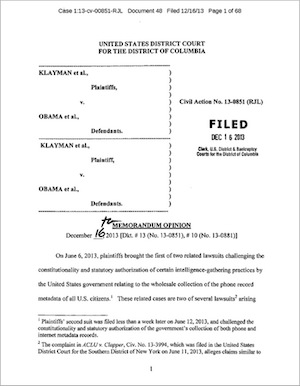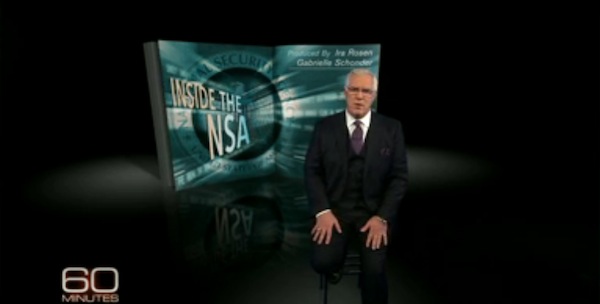A legal blow to NSA spying: After months of criticism and protests, the U.S. National Security Agency’s surveillance program received a more formal blow this week with a ruling by a federal judge that the program appears to violate the Constitution’s ban on unreasonable searches and seizures. The program has been ruled constitutional numerous times by judges in the U.S.’ secret surveillance court, but this was the first time a federal judge outside that court has ruled against it.
 The New York Times explained the ruling and the various responses to it, including a statement by document leaker Edward Snowden describing it as “the first of many.” The New York Times editorial board and USA Today’s Rem Rieder both praised the ruling as a powerful rejection of mass surveillance. Slate’s Emily Bazelon and The New Yorker’s Amy Davidson broke down the ruling in more detail, with Bazelon thanking the judge for a “wake-up call” and Davidson concluding that “Judge Leon plainly feels that he has been lied to, and that we all have been.”
The New York Times explained the ruling and the various responses to it, including a statement by document leaker Edward Snowden describing it as “the first of many.” The New York Times editorial board and USA Today’s Rem Rieder both praised the ruling as a powerful rejection of mass surveillance. Slate’s Emily Bazelon and The New Yorker’s Amy Davidson broke down the ruling in more detail, with Bazelon thanking the judge for a “wake-up call” and Davidson concluding that “Judge Leon plainly feels that he has been lied to, and that we all have been.”
Gregory Ferenstein of TechCrunch threw some cold water on the excitement, saying that nothing significant is likely to happen to the program as a result of this ruling, and any meaningful ruling will have to come from the Supreme Court. On the other hand, Ian Millhiser of ThinkProgress said the key to this ruling was that the technology of surveillance has so thoroughly changed that the 1970s-era judicial precedent doesn’t apply anymore. And Wired’s David Kravets said this ruling recognizes Snowden as a whistleblower, rather than a traitor.
Meanwhile, a presidentially appointed panel recommended significant limits to the program, calling for a third party to hold the data with the government only able to access it through a court order. As Ars Technica’s Nate Anderson noted, the panel’s report repeatedly asserted the privacy rights of foreigners as well. President Obama also met with tech executives, but gave them no commitment to limit government surveillance of web traffic.
Elsewhere, Snowden sent a letter to Brazil in which he expressed a desire to help the country counter NSA surveillance, but noted that he cannot speak freely about it until a country gives him permanent asylum. Journalist Glenn Greenwald said, however, that Snowden is not renewing his request for asylum in Brazil (which is currently pending).
CNN initially misreported that Snowden was offering to help Brazil spy on the U.S., earning condemnation from Greenwald and others. Techdirt’s Mike Masnick objected to the characterization that Snowden was offering some sort of help-for-asylum quid pro quo. The Washington Post’s Max Fisher said Snowden’s letter to Brazil doesn’t easily fit either the hero or traitor narrative, and his colleague Andrea Peterson wondered whether Snowden’s consecutive statements mean he’s seeking public attention for a particular reason.

60 Minutes’ NSA flattery: CBS News’ 60 Minutes touted a big story on the NSA surveillance beat when it got exclusive access to NSA officials to talk to them about their mass surveillance programs and Edward Snowden’s leaks. The story did contain one bit of pertinent news — that the NSA is considering granting Snowden amnesty in exchange for the return of its documents, a trial balloon that Reuters’ Jack Shafer examined more closely.
The piece’s reporter, John Miller, explained an behind-the-scenes interview with 60 Minutes that he didn’t want the story to be a puff piece. As it turned out, in the eyes of most every media critic who watched it, that’s exactly what he produced. The Wire’s Sara Morrison laid out a good, basic summary of the puffiness of the piece, and Mike Masnick of Techdirt highlighted a few elements: zero difficult questions, no NSA critics in the piece, unchecked ad hominem attacks against Snowden.
As Esquire’s Ben Collins pointed out, some of those details about Snowden were eerily personal. At The Guardian, Spencer Ackerman refuted several of the claims the NSA made in the piece, while Kevin Gosztola of FireDogLake focused on Miller’s own history in surveillance and law enforcement. Indeed, a few hours after the report aired, The New York Post’s Richard Johnson reported that Miller was planning to leave CBS to return to the New York Police Department.
The Nation’s Greg Mitchell called the report evidence that 60 Minutes’ decline is nearly complete, and J.K. Trotter of Gawker made the same point, arguing that the show’s accomplishments “can only be described in the past tense.” “Nothing is forever,” Trotter wrote. “It’s time to tear it down and build something new.” Timothy Karr of Free Press didn’t go quite as far, but said 60 Minutes really needs an ombudsman. Forbes’ Andy Greenwald, meanwhile, produced a sort of alternative picture of Snowden to the NSA’s, based on a former NSA staffer who called him “a genius among geniuses.”

Lessons from Patch’s demise: The New York Times’ David Carr reported this week that Patch, the massive hyperlocal news network founded by AOL CEO Tim Armstrong and owned since 2009 by AOL, is finally dying. AOL executives pushed back with an internal memo that contended that Patch is not being shut down, but that AOL continues to shop for partners to offload Patch sites onto.
As Carr noted, Patch’s struggles have been well documented over the past several years, and it announced large-scale layoffs and closings just a few months ago. Several people outlined lessons to take away from Patch’s long, slow demise, with the one unifying critique being Patch’s fast, haphazard growth, which Forbes’ Jeff Bercovici called its fatal error. CUNY’s Jeff Jarvis also said Patch adhered too closely to an old-media ad model and was too centralized.
Likewise, Michele McLellan of the Knight Digital Media Center said Patch didn’t do enough local advertising, and wasn’t local or independent enough in its reporting. Gawker’s Hamilton Nolan also argued that Patch didn’t think enough about how to beat out local newspapers for readers and local ad dollars. Bloomberg’s Megan McArdle said the scaling problem meant AOL never should have bought Patch in the first place.
Mathew Ingram of Gigaom said the problem isn’t that Patch scaled too quickly, but that it scaled at all. Hyperlocal journalism, he said “has never been a big business, and arguably never will be,” fueled instead by the passion of the small businesses or individuals who do it. Wired’s Ryan Tate pointed to several companies built around locally based ideas that are having to push beyond local media to keep revenues up, but The Washington Post’s Timothy B. Lee talked to a local blogger who said hyperlocal news there is alive and well. PandoDaily’s Adam Penenberg lamented that we ever thought hyperlocal news would save journalism in the first place.
News orgs end suppression of a CIA story: A story on a missing American in Iran that broke late last week raised questions about media-state relations and holding stories at the government’s request. The AP reported last week that Robert Levinson, who has been missing in Iran since 2007, was not there on private business as the CIA has claimed, but was instead working for the CIA.
The White House condemned the AP as being “highly irresponsible” for publishing the report, but the AP also noted that it held the story for three years at the government’s request. A U.S. Senator also said he urged the AP not to run the story. The AP’s executive editor, Kathleen Carroll, explained why it was publishing the story, arguing that it was important accountability journalism, and it’s impossible to know whether the story will put Levinson at risk.
The New York Times, which ran with the story a day after the AP did, also said it had held the story for six years, and ABC News said it had known, too. Gawker’s J.K. Trotter looked back at the two news organizations‘ past coverage of the story, noting that it contained assertions that the organizations knew were false. “It’s one thing for a news outlet to keep secrets at the request of the government, or in order to keep someone safe. It’s another thing to affirmatively and knowingly spread lies,” he wrote.
Reading roundup: A few other stories and pieces of commentary to surface this week:
— Aaron Kushner, the owner and publisher of the Orange County Register, announced plans to launch a new daily newspaper in Los Angeles called the Los Angeles Register early next year. Kushner gave The New York Times a few more details, including that the paper will be based on libertarian political principles, and media analyst Ken Doctor offered a thorough analysis of the move.
— The new Pierre Omidyar/Glenn Greenwald news organization has a name: First Look Media. As adviser Jay Rosen reports, it’s also getting its first $50 million from Omidyar, and will consist of both for-profit and nonprofit entities.
— The year-in-review posts are starting to trickle in, starting with Poynter’s annual collection of errors and corrections, headlined by 60 Minutes’ Benghazi story as its “error of the year.” The Lab ran its own mammoth series of predictions for 2014, with 36 contributors and counting. There’s enough good stuff there to spend a couple of hours reading through, but a few of my favorites were Adrienne LaFrance on rethinking beats, Raju Narisetti’s suggestions for recapturing the news brand, and Lauren Rabaino’s piece on contextual journalism.
— A few more pieces of the ongoing discussion on viral content: Slashdot’s Nick Kolakowski on Upworthy’s formula and its reliance on Facebook, CBC Radio and the Lab’s Joshua Benton on BuzzFeed’s viral verification (also reported in detail at Politico), and Matt Haughey’s prediction here at the Lab of viral hoaxes becoming a more normal and accepted part of the news cycle.
— EveryBlock is reportedly back from the dead. The data-based hyperlocal news site is being revived by Comcast, which owned it when it was shut down earlier this year, according to Chicago Grid.
— Finally, the Committee to Protect Journalists reported that 211 journalists were jailed for their work around the world this year, the second-worst year on record.